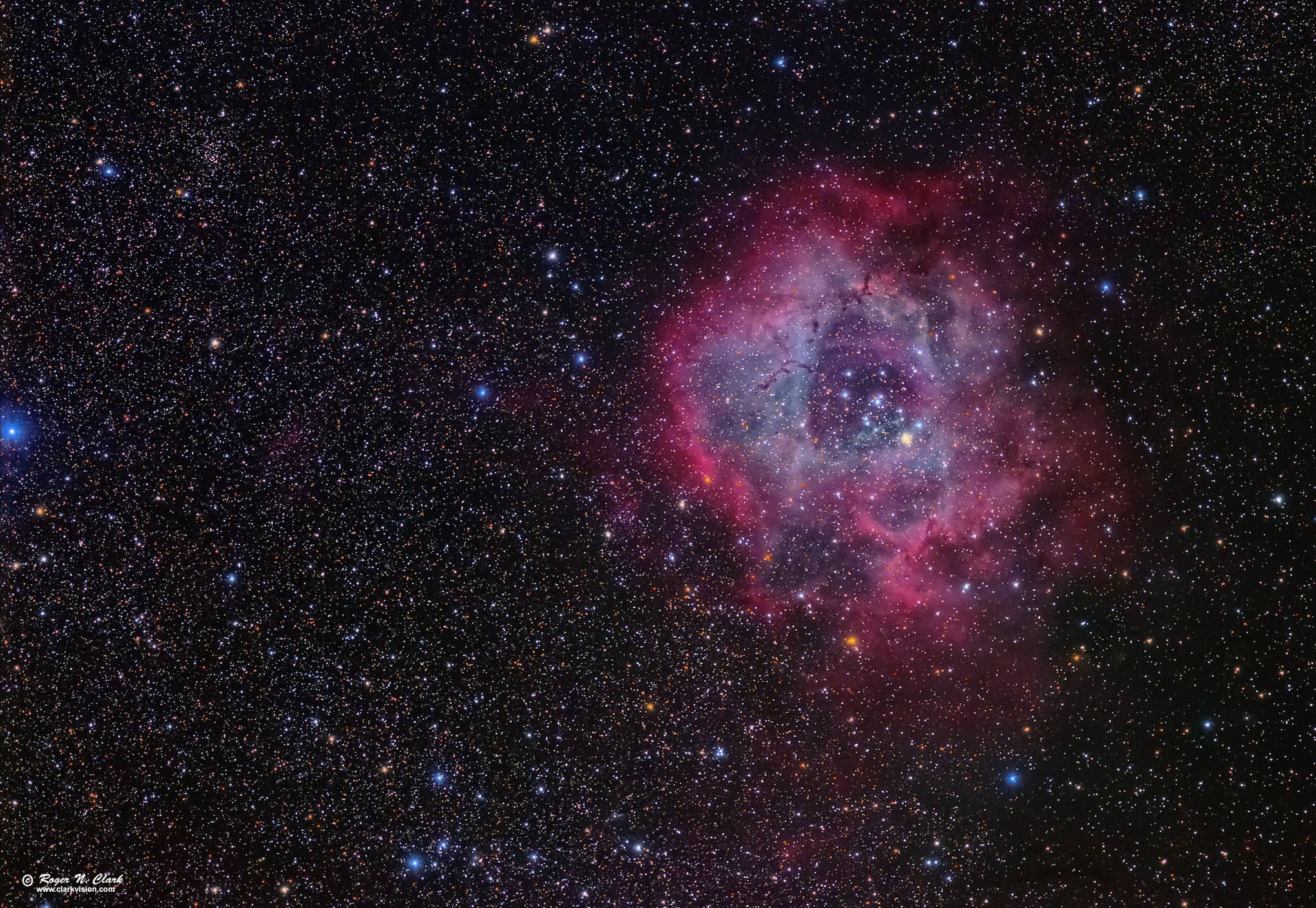| Home | Galleries | Articles | Reviews | Best Gear | New | About | Contact | Gallery Index | Previous |
Next |

| Home | Galleries | Articles | Reviews | Best Gear | New | About | Contact | Gallery Index | Previous |
Next |

Northeast of the constellation of Orion is the beautiful Rosette nebula, with the designations NGC 2237, NGC 2238, NGC 2239, NGC 2246 and the embedded star cluster NGC 2244, some 5200 light years from Earth. This is a region of star formation. The image here is made with a stock DSLR and the colors illustrate different processes in the nebula. The pink/red is from hydrogen emitting in the red (H-alpha) and blue (H-beta). The blue and gray is from starlight scattered by dust and from other atoms emitting light, including oxygen and sulfur. The small open cluster to the upper left is NGC 2236.
While the Rosette nebula resembles a rose, do you see the face? Do you see the smiling mouth with tongue sticking out?
This is a natural color image. The high dynamic range of astrophotos must be stretched to bring out the range of details the camera recorded. But the typical image stretch process loses color for brighter subjects (e.g. stars and the brighter parts of deep sky objects become whiter as they are made brighter). This image uses a new algorithm, rnc-color-stretch that does not lose color during the stretch. How do we know the colors are reasonable? The star colors can be checked against stellar photometry. Red stars have B-V > 2, orange stars have B-V of 1 to about 2. The blue-white stars have B-V in the range of 0 to -0.5. The colors closely follow the color sequence in Table 1 at Color of Stars. Solar-type stars have a B-V of 0.63 and appear close to white (daylight white balance).
Technical. Canon 7D Mark II 20-megapixel digital camera and 300 mm f/2.8 L IS II at f/2.8. Twenty nine 60-second exposures at ISO 1600 were added (29 minutes total exposure). The Rosette nebula is a very faint nebula, so this image demonstrates that the standard 7D Mark II is an amazing low light camera for it to record so much detail in this exposure. Full size image is at 2.8 arc-seconds per pixel, and the image here is 45% that (6.2 arc-seconds per pixel). No dark frame subtraction, no flat fields. Tracking with an astrotrac and no guiding.
Post processing: stretched with rnc-color-stretch. Also see Astrophotography Image Processing Basic Work Flow.
The Exposure Factors, CEF, CEFA are measures of the relative amounts of light received from a subject. It can be used to fairly compare wildly different lens/telescope apertures and exposure times. For this image:
Modern DSLRs like the 7D Mark II include on sensor dark current suppression and low fixed pattern noise at ISOs around 1600 and higher, making no need for dark frame subtraction. Modern raw converters correct for light fall-off and also correct for hot/dead/stuck pixels. This makes processing low light images easy: simply align and average. See my series on Astrophotography Image Processing for more details.
To learn how to obtain stunning images like this, please visit my Extensive Articles on Photography .
See my review of the Canon 7D Mark II and why it is so good for astrophotography: Canon 7D Mark II sensor analysis.
Keywords to this image = astrophoto-1 nebula digital_astro canon_7d2 rnc-color-stretch
Image ID: rosette_nebula_c01.22.2015-t2.0J6A3448-95av29-rs.h-0.45xc1s.jpg
| Home | Galleries | Articles | Reviews | Best Gear | Science | New | About | Contact |
Last updated November 03, 2025